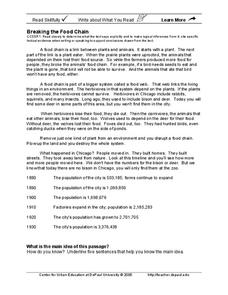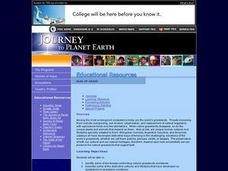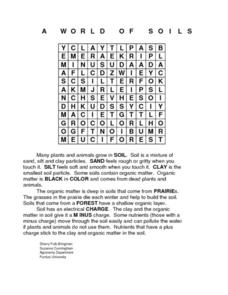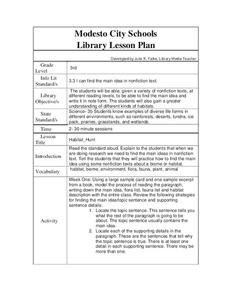Curated OER
The Formation and Value of Temperate Grasslands
Young scholars study the Temperate Grasslands biome of North America. They explain that it is an endangered ecosystem because the rich soils have been converted to farming in most areas. They view videos imbedded in this plan, then...
Curated OER
The Great Pollinators
Students discover the reproductive parts of a plant. In this biology lesson, students identify and categorize several different plants they dissect in class. Students record their information using a data chart.
Curated OER
The Oil Field Industry
A brief look at natural resources are described, prior to explaining the importance of oil in this 12-slide PowerPoint. Clear and colorful graphics are on each slide to keep viewers interested and more informed. Tip: Ask students how...
Curated OER
Where the Buffalo Roam
Second graders explore what life in the Chicago area was like hundreds of years ago. They discuss how settlers impacted the environment, and why there are no longer herds of buffalo in the Chicago area today. They read an article and...
DePaul University
Breaking the Food Chain
Throughout history, the growth of big cities has resulted in the destruction of ecosystems. In the case of Chicago, IL, a grassland that was once home to bison, deer, wolves, and foxes quickly became a booming city of over three million...
Curated OER
Mammals: Mammals and Their Ways
Middle schoolers, in groups, observe, collect data, and analyze mammal behaviors.
Curated OER
Seas of Grass
Students view a video clip about grasslands. They identify threats to grasslands and describe cultures which have adapted to grassland conditions. They discuss possible solutions to preserve grasslands as well.
Curated OER
The Web of Life
Students explore the interconnectedness of living things in an ecosystem. They use pictures and arrows to develop a food web, and participate in constructing a class food web with students representing various parts of the web.
Curated OER
Fires and Fire Suppression
Students examine their assumptions about forest fires. They explore the conflicts involved with the forest service's new strategy. in addition, they will study one case where a prescribed natural burn had a significant impact on a later,...
Curated OER
A World of Soils
For this word search worksheet, students read several paragraphs about the types of soil. Students then use the bold words to complete the word search puzzle.
Curated OER
Graze Like a Cow
Students explore how a cow digests the grass they eat. In this science/math lesson, students compare the quality of forage. Additionally, students determine the effects of rangeland health on the production.
Curated OER
Forest Fires
Students discuss the benefits and problems associated with fire. They discuss the role that fire plays in maintaining healthy ecosystems. Students brainstorm ways that fire can be harmful, such as damaging homes, communities, and...
Curated OER
Know Your Cousins - Monotremas, Marsupials, and Placentals
Students discover various mammals. In this biology lesson plan, students recognize characteristics of mammals and categorize mammal groupings. Students describe how mammals grow inside the mother's body and resemble their parents at birth.
Curated OER
Habitat Sunprints
Students recognize various habitats and where they are found. For this habitat sunprints lesson, students observe the contents of habitats and record what the sunprint might represent. Students use blueprint paper and small natural...
Curated OER
Scales, Scutes, and Skins
Students identify the various adaptations of reptiles and amphibians. After distinguishing between reptiles and amphibians, students discuss the ways in which their adaptations aid in their survival. They participate in a hands on...
Curated OER
Land Associations
Middle schoolers identify and explore life forms of various biomes, define transitional regions, examine effects of abiotic and biotic interactions, research a biome, and produce newspaper that features environmental information. Lessons...
Curated OER
WONDERFUL, WATERFUL WETLANDS
Learners list characteristics of wetland and describe the functions of a wetland.
Curated OER
Which One Matters?
Students study the balance necessary to maintain ecosystems and how changing that balance can impact the ecosystem. They identify and discuss the need for balance in any ecosystem and discuss how greenhouse gases impact ecosystems.
Curated OER
Web of Life
Students collect information about various organisms in a forest ecosystem and create a mural that depicts organism interdependence. They then simulate a food web using a ball of string.
Curated OER
Diverse Environments
Students explore life forms in different environments. After exploring different biomes within their state, students research different plant and animal species within each biome. They prepare a group report on one feature of the region...
Curated OER
Bison (American Buffalo)
In this science worksheet, students read the facts sheet for the buffalo. They could use this for a class activity for classifying animals.
Curated OER
Habitat Hunt
Third graders read several nonfiction texts and practice finding the main idea for the text as well as learn about various habitats. In this main idea instructional activity, 3rd graders read several nonfiction texts and make habitat...
Curated OER
Is There A Fungus Among Us?
Sixth graders classify fungus into two different groups. In this fungus lesson, 6th graders collect as many pieces of fungus as possible. Students then classify these pieces of fungus as saprophytic or parasitic.
Curated OER
Depending On Each Other. Communities And Ecosystems
Seventh graders investigate how the ecosystems of the world has influence upon the immediate and nonimmediate environments. The interelationships of food webs is discussed. The class researches one type of ecosystem for a class project...

























